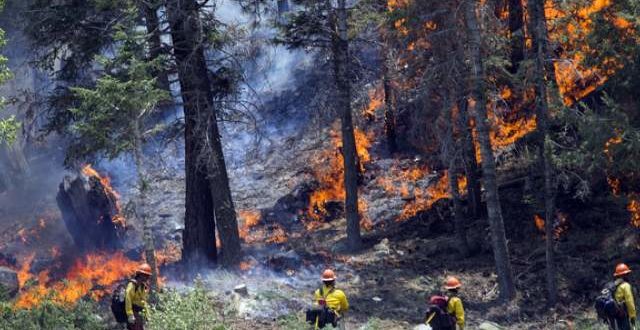Blaze’s spread shows toll of drought in southern California
Published on June 20th, 2015
Hot Shot crews from Mill Creek keep the Lake Fire from crossing a meadow to Heart Bar Training Facility on Friday, June 19, 2015, in the San Bernadino National Forest area of Angelus Oaks, Calif.
Paloma Esquivel and Rosanna Xia
June 19, 2015
Los Angeles Times
BIG BEAR, Calif. — California’s first major forest fire of the season, which has consumed more than 11,000 acres in the San Bernardino National Forest, is being fueled by nearly four years of drought.
The fire started Wednesday and quickly spread up the mountains, at elevations of 6,000 to nearly 10,000 feet. Under normal conditions, these areas would probably be wet from storms and perhaps still topped by snow.
“At higher elevation, normally you would have cooler temperatures and your rain and snow would linger longer into the spring or early summer,” said Lee Beyer, a U.S. Forest Service spokesman. “That’s definitely not the case this year.”
The fire burned into dry rugged terrain that had not seen a fire this large in more than a century, officials said. The forest is particularly vulnerable to fire because of a bark beetle infestation that has left dead trees throughout the forest.
Southern California wildfires are generally spread by hot Santa Ana winds that begin in the fall.
But this week, officials were alarmed at how quickly the Lake fire spread even with relatively low wind conditions. On Friday, winds were blowing about 8 mph to 10 mph, said Roger Pierce, a meteorologist for the National Weather Service in San Diego.
“The fire really took off, and we didn’t have that strong a wind environment for them,” Pierce said.
The blaze is 10 percent contained, and more than 1,200 firefighters are on the lines. Heavy smoke clouded Morongo Valley and poured into Coachella Valley. A NASA satellite image showed plumes of smoke all the way to Arizona.
The Lake fire erupted Wednesday afternoon near Jenks Lake Road in a part of the forest where several organizations, including Boy Scout troops and churches have summer camps. By Friday, firefighters were focusing on preventing the fire from crossing California 38, which winds through the mountains en route to Big Bear.
Just off the highway, John Ellison, superintendent of the Mill Creek Hotshots crew, and his team were preparing to set a controlled burn in hopes of keeping the blaze from racing down a hillside.
The hillside was dotted with pine and fir trees, some of which had burned and were falling in pieces to the ground.
“We’re getting into the time of the season where we’re going to start getting busy…. This is just our first real fire of the year,” he said.
William Patzert of the Jet Propulsion Laboratory in La Canada Flintridge said the hot, dry weather is coming from a high-pressure ridge.
The heat and low humidity have been troublesome for firefighters who are working to cut 10,000 feet of fire lines around the massive blaze.
Helicopters dropping water from local lakes have been working to put out the flames while hand crews trekked into the wilderness to fight the blaze from the ground.
“Water is still the best method for fire attacks,” California Department of Forestry and Fire Protection spokeswoman Liz Brown said. “Everyone’s been on water saving measures for this very reason.
”Although the fire is burning near Big Bear, it is heading east and not affecting recreational activities at Big Bear Lake, officials said. About 2,000 people have been evacuated as a precaution. The fire was threatening about 400 structures.
Big Bear resident Kristen Barden, who lives just outside of the stretch of highway that was closed to drivers, said the dry conditions made her particularly worried.
The situation near her home looked better Friday than it did Thursday, when smoke billowed over a nearby ridge and looked like “a bomb went off,” she said.
Nevertheless, her family had prepared a bag with pictures, hard drives, clothes, food and water, in case they were told to leave, she said.
“We haven’t had any rain,” she said. “That’s what’s so scary, (California) 38 is covered in dead trees, it’s just fuel.”
This year, researchers with the U.S. Forest Service surveyed 4.2 million acres of trees in the Cleveland, San Bernardino, Angeles and Los Padres national forests and found that 2 million trees had died because of drought and the invasion of bark beetles. The tiny bark beetle thrives in dry conditions, chewing away at pines and making them brittle.
“The tree kill, that also has played into why these really thick trees that normally would be able to survive fires really just aren’t able to right now,” Brown said.
The forest also provides much heavier fuel than the chaparral that burns in brush fires at lower elevations.
Timber in higher elevation areas takes longer to mature into dense forest. But decades of growth and a few dry years have made this area of forest ripe for large fires.
And it’s not just the old, thicker forests that are a concern this season, Brown said. Small amounts of precipitation last winter have brought concerns over “fuel reloading” — when a little moisture can help sprout new blades of grass and vegetation, which dry out and add more fuel for a fire.
“When we do get to that later season, which is our typical high peak season, we may see more explosive fire behavior,” she said. – See more at: http://amestrib.com/news/blaze-s-spread-shows-toll-drought-southern-california#sthash.2k1Ndu8G.dpuf





